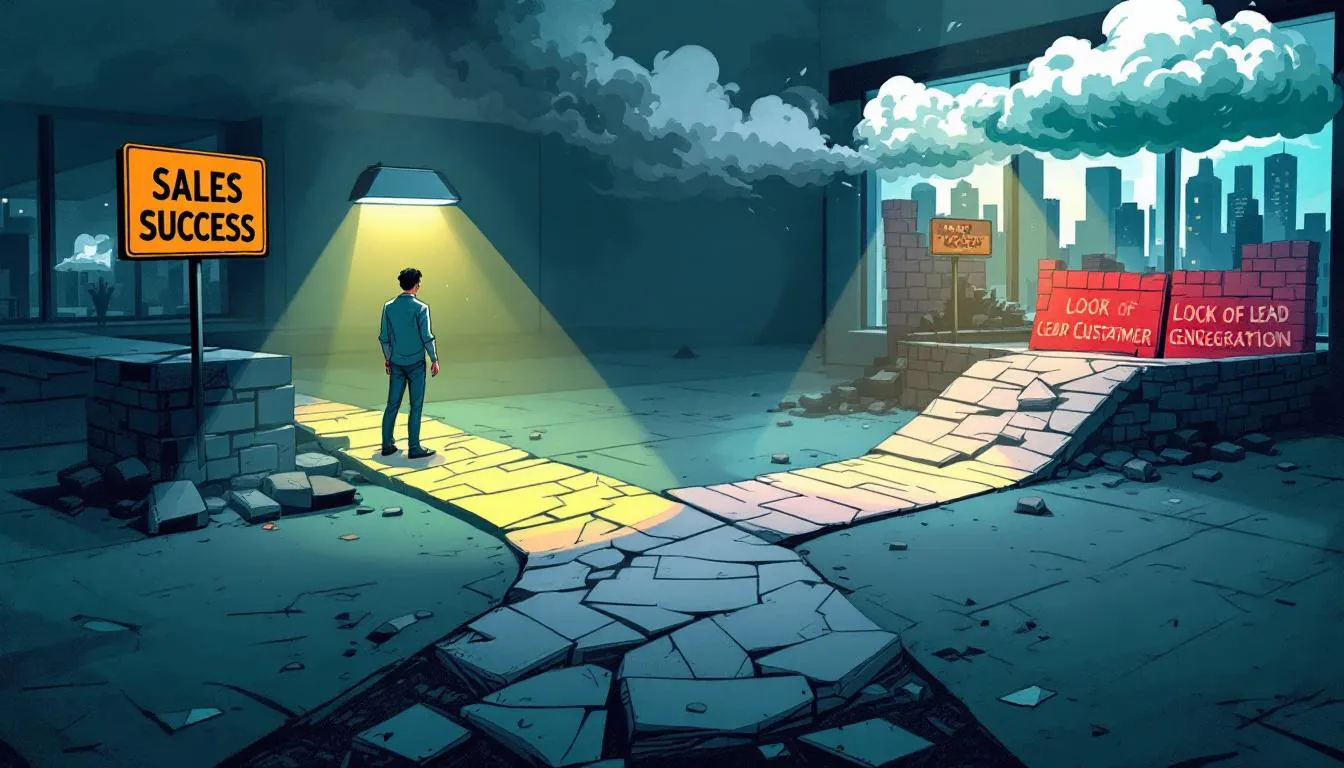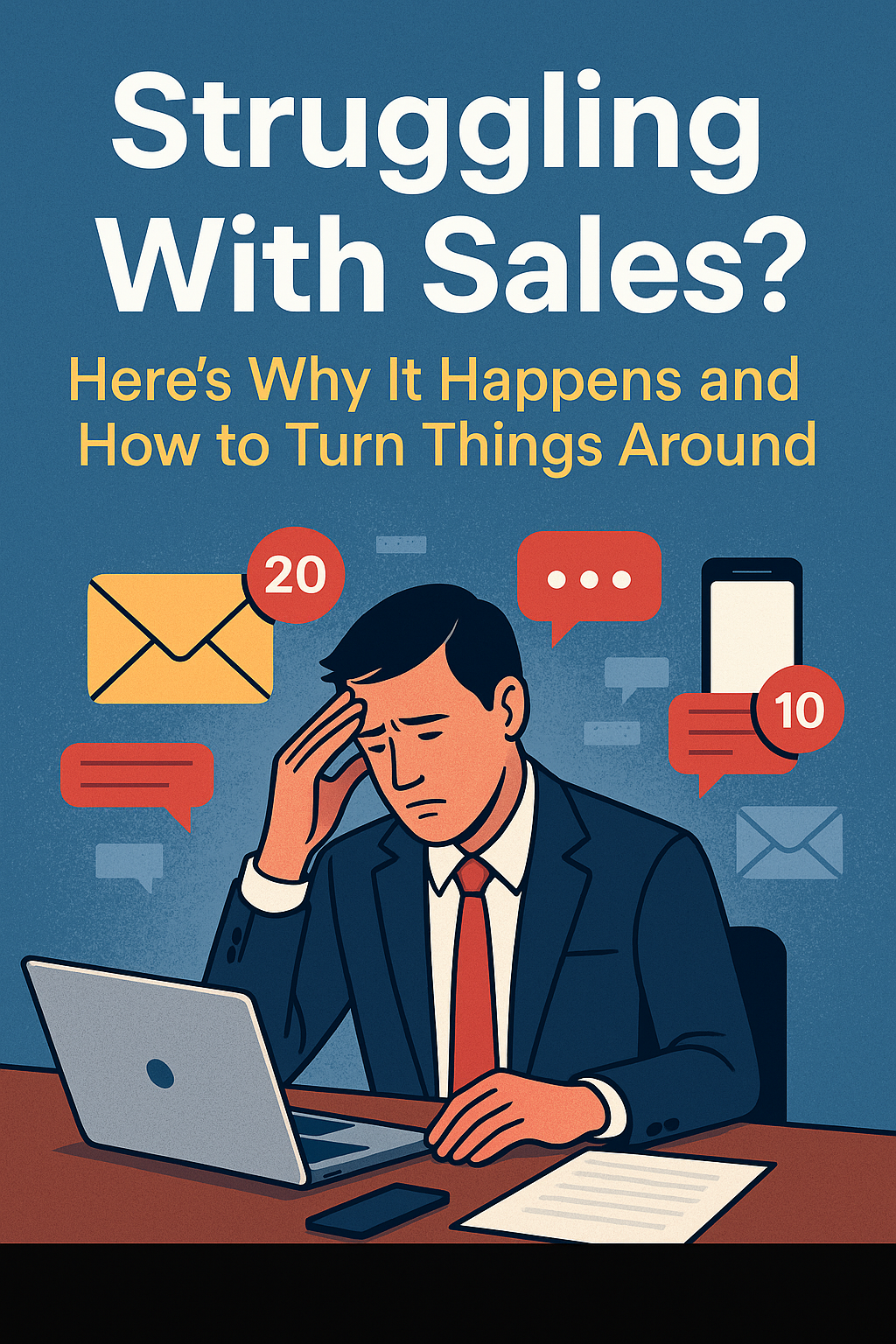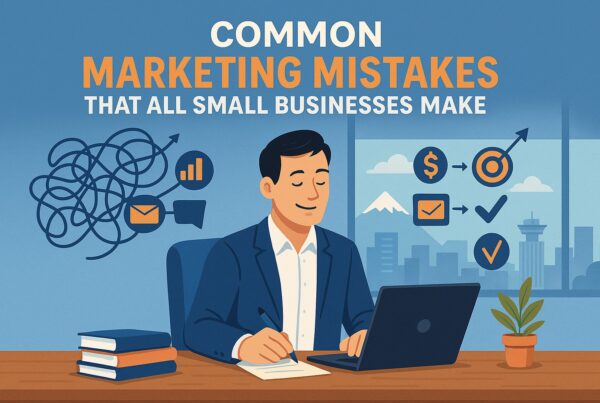Struggling With Sales? Here’s Why It Happens and How to Turn Things Around
If you’re struggling with sales despite having a great product or service, you’re not alone. The rules of engagement have fundamentally changed in today’s marketplace, and the strategies that delivered success in the past are increasingly falling flat. Modern buyers receive over 100 emails daily and have zero tolerance for transparent sales pitches that fail to deliver immediate value, making it crucial to be interesting to capture their attention and facilitate meaningful conversations.
👉 If you’re tired of shouting into the void with no replies, let’s talk about a smarter approach. Book your free 15-minute strategy call now.
This comprehensive guide examines why sales challenges persist, even for experienced professionals, and offers actionable solutions to transform your approach in an increasingly competitive world.
Key Takeaways
- Sales struggles stem from outdated approaches that focus on closing rather than building genuine relationships.
- Modern buyers receive 100+ emails daily and have zero tolerance for transparent sales pitches.
- Success requires shifting from “selling yourself” to demonstrating clear value and transformation.
- Administrative burdens and unrealistic quotas are burning out even top performers.
- The solution lies in human-centred conversations, realistic goal-setting, and integrated sales and marketing approaches.
- Owning the job of sales is essential for business leaders and salespeople; it should not be outsourced or neglected as a secondary task.
📈 Want to apply these insights to your own sales process? Let’s map it out together—book a 15-minute call here.
Why Traditional Sales Approaches Are Failing
The sales techniques that worked a decade ago are increasingly falling flat in today’s marketplace, where buyers are overwhelmed with similar-sounding pitches from countless competitors. Traditional sales approaches often focused on persuading customers through sales techniques and closing strategies, but these methods now seem outdated. What’s changed?

Information Overload and Buyer Independence
Today’s buyers receive over 100 emails daily, creating an environment where prospects have developed sophisticated filtering mechanisms that make most sales outreach invisible. This communication overload has fundamentally altered how buyers respond to sales messages. Many prospects are not initially interested, making it even more challenging for salespeople to break through the noise.
“Most people don’t realize that the real challenge occurs before closing – it’s getting prospects to engage in meaningful conversations in the first place,” explains many sales leaders who are witnessing this shift firsthand.
The Research Revolution
The internet has dramatically transformed the buyer’s journey. Thanks to the wealth of information available online, buyers now conduct extensive research before engaging with salespeople. By the time they talk to a salesperson, they’ve often already:
- Researched multiple competitors
- Read reviews and testimonials
- Formed opinions about pricing and value
- Developed specific questions about your offering
🔍 Are your prospects finding what they need before you even say hello? Let’s discuss how to stay ahead of their journey.
Traditionally, the sales process was centred around making the sale, with a strong focus on closing techniques and persuading customers. However, this shift means that traditional closing techniques, which worked when sales reps controlled information, now feel pushy and inauthentic to modern buyers who arrive educated and skeptical. Now, a more consultative approach is required to build trust and address the buyer’s needs.
The Relationship Gap
In many cases, sales training focuses solely on techniques and tactics rather than building genuine relationships. This creates a disconnect that makes perfect sense when you consider today’s business environment—buyers don’t just purchase products; they invest in relationships with people they trust.
While building rapport is essential, remember that your goal is not to become a friend, but to be a trusted advisor focused on delivering results for your clients.
The Hidden Obstacles Sabotaging Your Sales Success
Beyond the obvious challenges, there are hidden obstacles that silently sabotage sales performance even among the most talented sales teams.

Email Invisibility
The struggle to stand out in crowded inboxes represents one of the most significant challenges for sales professionals. Prospects often delete sales emails within seconds of receiving them, creating an “invisibility problem” that makes initiating conversations increasingly difficult.
This issue gets worse when:
- Subject lines sound generic or sales-focused
- Opening paragraphs fail to demonstrate immediate relevance
- Messages focus on the company rather than the prospect’s challenges
✉️ Struggling to get replies? It’s not your product—it’s your message. Book a quick call and let’s fix your first impression.
The Administrative Burden
The technology meant to help sales reps (CRMs, sales enablement tools, etc.) often creates an administrative burden that forces reps to spend more time typing than talking to customers:
| Activity | % of Sales Rep Time | Impact on Sales |
|---|---|---|
| Administrative tasks | 30-40% | Reduces customer conversation time |
| Data entry | 15-20% | Creates frustration and burnout |
| Meetings & internal calls | 10-15% | Limit prospecting activities |
| Actual selling time | 25-45% | The only activity that generates revenue |
This administrative overhead consumes hours that should be spent with clients and prospects, creating a significant drag on productivity and results.
Unrealistic Quotas
Sales teams frequently face pressure from unrealistic quotas that increase year-over-year without additional support or resources. Raising quotas without support makes it increasingly difficult for sales teams to close more deals, as they lack the necessary tools and resources to meet higher expectations. This creates undue pressure and contributes significantly to burnout among sales professionals.
“The truth is that constantly raising targets without providing new tools, training, or market opportunities sets teams up to fail,” note experienced sales leaders who’ve seen this pattern play out repeatedly.
Leadership and Strategy Gaps
Many organizations face leadership vacuums in sales when executives mentally outsource the function, which can kill pipeline energy and momentum. At some point, leadership must be actively involved in sales strategy to prevent pipeline stagnation and ensure continued performance. Common leadership issues include:
- A disconnect between marketing and sales on lead definitions
- Micromanagement that frustrates high performers and kills motivation
- Treating sales like a machine instead of a living system requiring nurturing
- Failure to create clear, repeatable processes that sales reps can follow
The Psychology Behind Sales Struggles
The truth about sales struggles often lies not in techniques or processes, but in the psychological impact that constant rejection and pressure create for sales professionals. However, you should not worry excessively about rejection or immediate results—maintaining consistency and focusing on long-term progress is what truly matters.
The Self-Worth Trap
Focusing on “selling yourself” can trigger self-doubt and compromise authenticity in customer interactions. When a salesperson’s sense of personal value becomes tied to their sales success, each rejection feels like personal failure rather than a business outcome.
This creates a dangerous cycle:
- Salesperson ties self-worth to sales success
- Rejection feels like personal rejection
- Confidence drops, affecting future interactions
- Performance suffers, reinforcing negative self-perception
- Burnout and diminished results follow

The Burnout Factor
Constant rejection combined with quota pressure leads to widespread burnout among sales professionals. This problem has intensified with the rise of virtual selling, making it more challenging to build genuine trust and personal connections.
A salesperson experiencing burnout typically shows:
- Decreased enthusiasm when talking to prospects
- Reduced ability to handle objections creatively
- Less persistence in following up
- Diminished quality in proposal creation
- Lower overall activity levels
⚠️ If sales is draining your energy instead of fueling growth, it’s time for a reset. Let’s create a more sustainable sales rhythm together.
The Trust Deficit
Prospects increasingly view salespeople as interchangeable vendors rather than trusted advisors. This perception creates an uphill battle where salespeople must first overcome negative stereotypes before they can even begin the actual sales process.
Building Conversations Instead of Pitches
The most successful sales professionals have made a critical shift from delivering pitches to building genuine conversations that focus on client value. Adopting a conversation-led approach, which emphasizes value and empathy, is more effective than traditional pitching because it fosters trust and meaningful engagement.
Lead with Value, Not Products
When you lead with genuine value and ask for perspectives rather than pushing products, you fundamentally change the dynamics of the sales interaction. This approach positions you as a consultant rather than a vendor. By focusing on value, you increase the likelihood of a successful sale, as you build credibility and foster meaningful conversations that address the prospect’s real needs.
For example:
- Instead of: “Our solution helps companies increase sales by 30%.”
- Try: “Many companies in your industry are struggling with [specific challenge]. What’s your experience been with that issue?”
Empathy-Driven Outreach
Using empathy and relevance in outreach encourages authentic responses from prospects. Embracing the idea that successful sales require a shift in mindset—not just relying on tactics—can make your outreach more effective. This approach requires doing homework before reaching out:
- Research the prospect’s company and recent business developments
- Identify potential pain points based on industry trends
- Connect your message to their specific situation
- Focus on creating a conversation, not pushing for a meeting
Focus on Transformation
The difference between average and exceptional sales professionals is that the latter focus on the transformation and results that clients will achieve, rather than their personal likability or product features.
“Clients don’t buy products or services—they buy outcomes and transformations,” explains sales leaders who consistently exceed targets. “When you help them visualize the future state your solution enables, price becomes less of an obstacle.” Effective sales conversations guide clients to trust, believe, and ultimately decide to move forward, as they see the value and transformation your solution provides.
Modern Prospecting Strategies That Work
Effective modern prospecting strategies create multiple touchpoints and demonstrate value at each interaction:
- LinkedIn outreach that’s human – Personalized connection requests and messages that reference specific points from their profile or recent activity.
- Consultative email campaigns – Messages that lead with insights relevant to the prospect’s industry or role, avoiding sales language in early communications.
- Multi-channel approaches – Combining social selling, referrals, and strategic prospecting creates a more robust presence in the prospect’s awareness.
- Content sharing with perspective – Sharing helpful content consistently to build awareness and trust over time, always adding your insights rather than just forwarding links, and avoiding the temptation to drop irrelevant or off-brand content that doesn’t support your sales goals.
🤝 If your outreach isn’t opening doors, you might be knocking the wrong way. Schedule a 15-minute call to refine your prospecting game.
Systematic Solutions for Sustainable Sales Growth
Overcoming sales challenges requires more than just motivational talks – it demands systematic solutions that create predictable, repeatable success.
Clear Sales Processes and Systems
A sales team without effective or repeatable sales processes faces significant disadvantages in today’s marketplace. The most productive sellers follow a consistent series of steps for prospecting, nurturing, negotiating, and closing in an orderly and predictable fashion. A well-defined sales process acts like a course or blueprint, providing a structured program that guides sales reps toward consistent results.
Effective sales processes include:
- Clear definition of each sales stage
- Specific activities required to advance opportunities
- Documented best practices for handling common objections
- Templates and frameworks for key customer communications
- Metrics to track progress through the sales funnel

Integrated Sales and Marketing
The struggle to generate leads and close deals often stems from treating sales and marketing as separate functions rather than aligned teams working toward common goals. A strong brand, built through aligned sales and marketing efforts, enhances trust and long-term engagement with potential customers.
Successful integration includes:
- Shared definitions of qualified leads
- Joint planning of content and campaigns
- Regular communication between teams
- Aligned metrics and reporting
- Feedback loops to improve lead quality
CRM Automation and Administrative Efficiency
Using CRM automation reduces administrative burden and allows sales representatives to focus on customer conversations. Many of these automations and templates are created to streamline repetitive tasks and improve efficiency. This efficiency gain can have a significant impact on productivity and results.
Priority automations include:
- Email sequence management
- Activity logging
- Proposal generation
- Meeting scheduling
- Follow-up reminders
Realistic, Data-Driven Quotas
Setting realistic quotas with input from sales representatives improves achievability and morale. Specific, measurable goals with timeframes are more effective, such as:
- Increasing qualified leads by 20% over the next quarter
- Improving conversion rates by 10% within three months
- Reducing the sales cycle from its current length to a shorter timeframe
“The mistake many businesses make is setting quotas based on what they want to achieve rather than what the market and team capacity can realistically deliver,” notes experienced sales leaders.
Supporting Your Sales Team’s Success
The human element remains crucial in sales, and supporting your team’s mental and professional development has a direct impact on results.

Addressing Burnout
Providing mental health support, flexible hours, and breaks helps combat burnout among sales professionals. The emotional toll of constant rejection, combined with pressure to meet quotas, requires systematic support.
Effective approaches include:
- Regular one-on-one check-ins focused on wellbeing, not just numbers
- Creating “no-meeting” days to allow focus time
- Celebrating efforts and process adherence, not just outcomes
- Encouraging time off to recharge
- Providing mental health resources and support
Skills Development and Coaching
Offering ongoing training in trust-building, active listening, and empathy enhances sales effectiveness and fosters stronger customer relationships. Focusing on coaching and results-based management, rather than micromanagement, yields better outcomes.
The difference between training and coaching is important:
- Training teaches new skills and knowledge
- Coaching helps apply those skills in specific situations
Effective sales coaching includes:
- Regular observation of sales conversations
- Specific, actionable feedback
- Role-playing difficult scenarios
- Building on strengths rather than just fixing weaknesses
- Celebrating improvement and growth
Recognition and Team Building
Celebrating achievements and fostering team camaraderie builds resilience. Recognition helps maintain motivation during challenging periods and reinforces successful behaviours.
Beyond commission structures, consider:
- Peer recognition programs
- Public acknowledgment of wins and milestone achievements
- Team-building activities that create genuine connections
- Sharing success stories and the lessons behind them
- Creating opportunities for team members to learn from each other

Overcoming Specific Sales Challenges
Let’s address specific obstacles that frequently derail sales efforts and the practical solutions to overcome them.
Combat Email Invisibility
With prospects receiving over 100 emails daily, breaking through requires strategic approaches:
- Personalized subject lines that reference specific company challenges or recent events
- Value-first opening sentences that immediately demonstrate relevance
- Brevity and clarity in message structure
- Question-based endings that invite response without pressure
- Timing optimization based on the prospect industry and role
Reduce Meeting No-Shows
Meeting no-shows damage rep confidence and waste valuable selling time. Effective prevention strategies include:
- Sending value-adding pre-meeting materials that increase anticipation
- Using calendar tools with automatic reminders
- Confirming via text or messaging apps close to meeting time
- Creating clear agendas that communicate the meeting value
- Following up on no-shows with helpful resources rather than guilt
Address Budget Constraints
In today’s budget-conscious environment, effective sales professionals:
- Focus conversations on ROI and business impact, helping clients see how they can afford the investment
- Offer flexible payment options to accommodate budget cycles and make it easy for clients to pay through clear processes
- Create tiered solutions at different price points
- Build compelling business cases that help champions sell internally
- Demonstrate the cost of inaction, not just the price of the solution
Build a Pipeline Through Strategic Lead Generation
When marketing budgets are cut, sales teams can still build a pipeline through:
- Strategic use of LinkedIn for direct outreach
- Leveraging existing client relationships for referrals
- Creating valuable, shareable content and sharing useful stuff that prospects find valuable and want to engage with, generating inbound interest
- Hosting educational webinars or events that attract qualified prospects
- Partnering with complementary providers to access new audiences
Develop Predictable Revenue-Generating Behaviours
Consistency creates predictability in sales. The most successful sales professionals:
- Block dedicated time for prospecting activities
- Create daily and weekly activity targets (calls, meetings, proposals)
- Track leading indicators of sales success, not just results
- Analyze what works and systematically replicate it
- Constantly refine their approach based on market feedback

The Shift from Transaction to Transformation
The most fundamental change required in modern sales is shifting focus from transactions to transformations. Today’s buyers are not just purchasing products or services; they’re buying outcomes and results.
This shift requires:
- Deeper knowledge of customer challenges – Understanding the business and personal pain points driving purchase decisions.
- Solution positioning – Framing offerings as solutions to specific problems rather than generic products or services.
- Value articulation – Communicating the concrete value and return on investment (ROI) that your solution delivers.
- Future-state visualization – Helping prospects see and feel what success with your solution looks like.
- Partnership mindset – Approaching relationships as ongoing partnerships rather than one-time transactions.
The ability to facilitate this transformation journey for clients represents the true value of modern sales professionals. When buyers sense this genuine commitment to their success, price sensitivity decreases and trust increases. With consistent effort, trust and sales success will eventually follow.
🚀 Ready to stop struggling and start selling with confidence? Click here to book your free 15-minute strategy call.
FAQ
Why do I struggle with sales even after training?
Sales training often focuses on closing techniques rather than building genuine relationships and having meaningful conversations that modern buyers expect. Success comes from applying what you’ve learned in ways that feel authentic to you and valuable to your prospects.
How can I overcome the fear of selling myself?
Stop focusing on selling yourself and instead concentrate on the transformation and results you provide to clients – they buy outcomes, not personalities. When you shift your focus from your performance to their needs, the pressure diminishes and your authenticity increases.
What’s the biggest mistake businesses make with sales?
Treating sales like a machine that can be automated or outsourced rather than a living system requiring constant nurturing and human connection. Sales is fundamentally about trust-building, which requires genuine human interaction and understanding.
How do I get prospects to respond to my outreach?
Lead with genuine value, ask for diverse perspectives, incorporate personal touches, and prioritize building meaningful conversations rather than making immediate sales pitches. Most people respond when they sense you’ve taken time to understand their specific situation and have something valuable to offer.
Why are my sales reps burning out?
Unrealistic quotas, excessive administrative tasks, micromanagement, and constant rejection can create emotional burnout, which requires systematic support to address. Creating an environment that acknowledges the human impact of these pressures and provides appropriate support is essential for sustainable performance.
The truth is that struggling with sales doesn’t mean you or your team lack ability—it often means your approach needs to be updated to match today’s buyer expectations and marketplace realities. By implementing the strategies outlined in this article, you can transform sales challenges into opportunities for deeper customer connections and sustainable growth.
🎯 The right guidance can make all the difference. Let’s uncover what’s holding you back—book your 15-minute call today.



